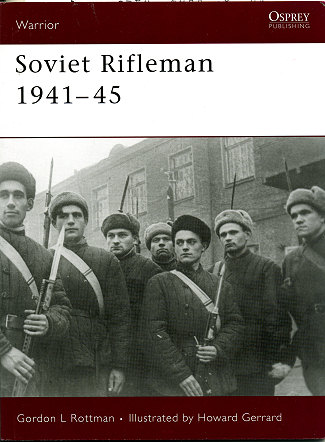 Number
123 in the 'Warrior' series is this book on the Soviet rifleman during the Great
Patriotic War. Most of us outside of Russia don't think much about this portion
of WWII, but it was where the major concentration of the German army and
equipment was sent.
Number
123 in the 'Warrior' series is this book on the Soviet rifleman during the Great
Patriotic War. Most of us outside of Russia don't think much about this portion
of WWII, but it was where the major concentration of the German army and
equipment was sent.
We also don't think much about what it might have been like
to be a 'standard' Soviet soldier. All we hear are numbers, most of them in the
millions, when it comes to killed and wounded. The truth is that the Soviet
Union needed soldiers to fight at the front, especially after the disasters of
1941 when a huge percentage of the Soviet army was either captured or killed in
the early months of the German Blitzkrieg.
The result is that these men who were conscripted or joined,
had very little in the way of useful training before being tossed into the war.
Even in the best of times, training was little more than how to obey orders and
minimal tactical training. Often these men had fired few rounds through the
various weapons and frequently trained with sticks as there were no guns for
them to use, these often being issued at the railhead near the front lines.
There were extreme cases where one man was given a gun and the next told to get
one from the dead.
Author G. Rottman does a very good job of portraying what it
must have been like to be one of these men. It isn't a pretty picture when
compared to what many of us have gone through in our own military experiences.
These men were poorly fed, given minimal equipment, lived in crowded and often
unhygienic conditions, yet were mostly willing to do what they could to stem the
tide of the invaders. These frequently illiterate men showed great bravery and
were often well let by junior officers, who constantly had to work around the
stupidity of their senior officers or the meddling of the political officer that
was assigned to each unit.
The book is developed around the now familiar format of an
introduction, how Soviet conscription worked, their training and tactics, how
the looked, weapons and equipment, their conditions of service and how they
lived while on campaign. Then there are sections on belief and belonging,
experiences in battle and how they were treated after the battles were over.
this is followed by a section on museums and collections as well as a
bibliography. All of this is superbly illustrated by H. Gerrard in several color
plates as well as a well done choice of period photographs.
It all makes for a book that is both interesting and
informative. One I know you will enjoy reading.
November 2007
For more on the complete line of Osprey books,
visit www.ospreypublishing.com. In the US, it is
Osprey Direct at 44-02 23rd St, Suite 219, Long Island City, NY 11101., where you can
get a catalogue of available books.
If you would like your product reviewed fairly and quickly, please contact
me or see other details in the Note to
Contributors.
 Number
123 in the 'Warrior' series is this book on the Soviet rifleman during the Great
Patriotic War. Most of us outside of Russia don't think much about this portion
of WWII, but it was where the major concentration of the German army and
equipment was sent.
Number
123 in the 'Warrior' series is this book on the Soviet rifleman during the Great
Patriotic War. Most of us outside of Russia don't think much about this portion
of WWII, but it was where the major concentration of the German army and
equipment was sent.